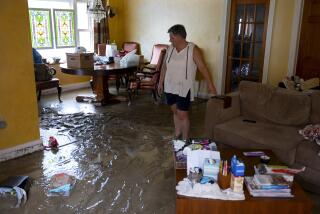Flood Leaves Thousands Without Clean Water : Disaster: Rain-swollen river contaminates treatment plant in Des Moines. Other towns brace for worst.
INDIAN GRAVE, Ill. — Lightning strikes over the Mississippi River marked the path of an incoming thunderstorm early Sunday, a deluge that dropped 10 inches of rain on Iowa in a day and added to the calamity from one of the most destructive floods ever to swamp the upper Midwest.
In Des Moines, 220 miles to the northwest, the storm washed out the city’s only water treatment plant, contaminating the water supply for 250,000 residents.
The treatment facility was knocked out when the Raccoon River rose past the plant’s dikes. Electricity was also lost, taking pumps out of service and leaving 45,000 people without power.
The city has declared a water emergency, warning that all water should be considered contaminated. Officials said it could be weeks before the plant can resume operation. By Sunday afternoon, National Guard troops were bringing in safe water, but all major roads into Des Moines were closed, complicating the task.
For those watching the early-morning storm from Indian Grave, on the Illinois side of the Mississippi, its destructive force was just a light show hinting of trouble to come.
Just before midnight, the town’s 12-mile-long sand barrier against the Mississippi was holding, and the last convoy of National Guard sandbaggers had just left for their bivouacs, taking their portable klieg lights with them.
The only workers left along a dim stretch of the levee were Lewis Klement and Brian Corrigan, patrolling for leaks and water boils in the dark. They pawed at clouds of mosquitoes and listened to the sound of the rising water.
“All that water,” said Klement, 19, a truck worker’s son. “You think she’d give us a break, just a bit. It’s like this river was out for revenge.”
As National Weather Service officials predicted that the flood-fueling storms would break soon, other Midwestern communities were warned to expect more flooding as rivers continue to rise.
Officials said they are hoping that the flooding will taper off near where the Mississippi and Ohio rivers meet at Cairo, Ill.. The Mississippi is able to handle more water there, and the Ohio’s water flow is normal.
But each morning brings a fresh roster of dashed levees, their ruptures reported like the fall of remote forts. As of Saturday, according to the Army Corps of Engineers, more than 276,000 acres--or 431 square miles--of land were under water.
The river has lapped out to 8 1/2 miles beyond its banks in some places, slicing off roadways and undermining bridge supports.
The latest rash of bridge closures has left a single two-lane concrete span at Quincy, Ill., just south of Indian Grave, as the only remaining river crossing between St. Louis and Muscatine, Iowa, a distance of 220 miles.
Rural highways and fire roads were filling Friday night and Saturday with evacuees. More than 20,000 people have been evacuated from low-lying areas since the flood started and at least 21 people have drowned. Government estimates of $2 billion in property and crop damage are expected to rise, officials said.
The muddy torrent from the river has already broken crest records from St. Paul, Minn., to St. Louis. But it is the Mississippi’s awesome volume of water, its ability to maintain punishing heights day after day without any sign of receding, that has taxed 500 miles of levees and barriers and broken the spirits of hardy river people.
“We’ve never been tested like this before,” said Ed Adcox of the Corps of Engineers. “You may not see another flood of this magnitude for 500 years.”
Flood crests are repeatedly revised and delayed--clear signs that the water will not go down anytime soon. The river had been expected to crest at Quincy, a river town of 40,000 just south of the Indian Grave levee, on Sunday. But steady rains and massive reservoir releases in Iowa are now delaying the projected record 32-foot crest until Tuesday.
Army engineers have told local officials that the Mississippi will probably remain at near crest for at least a week after it hits its final high-water mark.
And officials say the continuing surge could be further lengthened by more rain.
National Weather Service Director Elbert W. Friday Jr., speaking on CBS-TV’s “Face the Nation,” said weather patterns appear to be returning to normal, promising some relief in about two days.
But he added that so much rain has fallen that some flooding could last through August.
Hydraulic engineers monitoring the river’s volume say that every second, the Mississippi is pumping nearly 10 times the amount of its normal rate of water--an irresistible force that laps over the tops of levees and eats away at their bottoms.
At Hannibal, Mo., water is passing by at a rate of 500,000 cubic feet per second--compared to its normal volume of 69,000 cubic feet, according to Corps of Engineers spokeswoman Denise Yale.
“That’s why the levees are so stressed,” she said. “They’re not only getting it at the top. They’re getting incredible pressure on every square inch.”
A flood barrier ruptured at Niota, Ill., about 40 miles north of Indian Grave. Nearly 400 residents had already left, and 60 more homes were evacuated Sunday morning as the flood plain began to fill with silt-choked water, town officials said.
Klement and Corrigan heard about the break on their radios, but they had only to flick on their flashlights and walk a few hundred yards toward the nearby Lima Lake levee to see plain evidence of the fate that may await Indian Grave.
A spreading brown swamp covers more than 30,000 acres of prime farmland. Brackish water gushes in from a break in the levee. The water mark has nearly reached the roofs of farmhouses.
Only the phantom outline of a grain elevator and the tops of cottonwood and burr oaks can be seen easily above the flood plain.
The Lima Lake levee fell on Friday at dusk, about the same time flood workers at Indian Grave beat back the water--for the time being.
The river had come within two inches of the top of the Indian Grave flood wall--one farmer measured it with a stick--but the water line held.
But Klement told the dirty secret of sandbaggers: the knowledge that one town’s inundation is another town’s salvation. Just hours after the Lima Lake levee gave way, the water level at Indian Grave and Quincy suddenly dropped by 1 1/2 feet. Each time a levee breaks, the water flowing into that stricken flood plain buys time for farms downstream.
“If Lima Lake held, we could’ve been the ones high-tailing it out of here,” Klement said.
Corrigan, a farmer from Loraine, Ill., 15 miles to the east, laughed and then sighed. His face lit up for a second, exposed by the distant lightning. It was caked with sand and red with mosquito bites.
“The river chooses who she wants to save and who she wants to bury,” he said.
More to Read
Sign up for Essential California
The most important California stories and recommendations in your inbox every morning.
You may occasionally receive promotional content from the Los Angeles Times.









